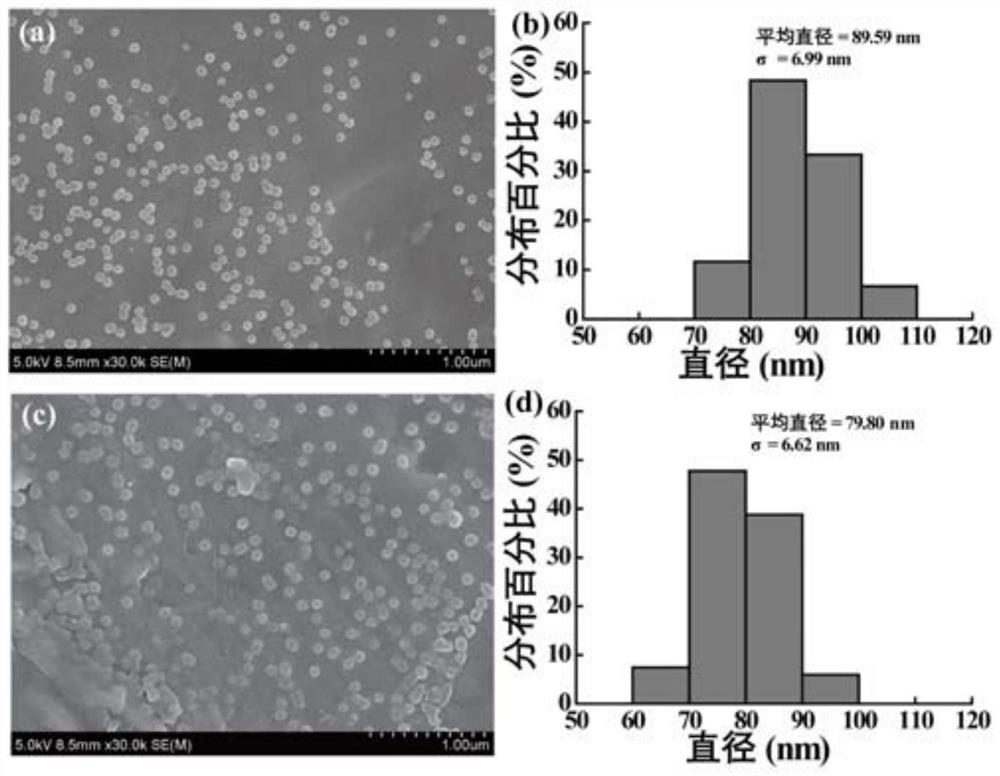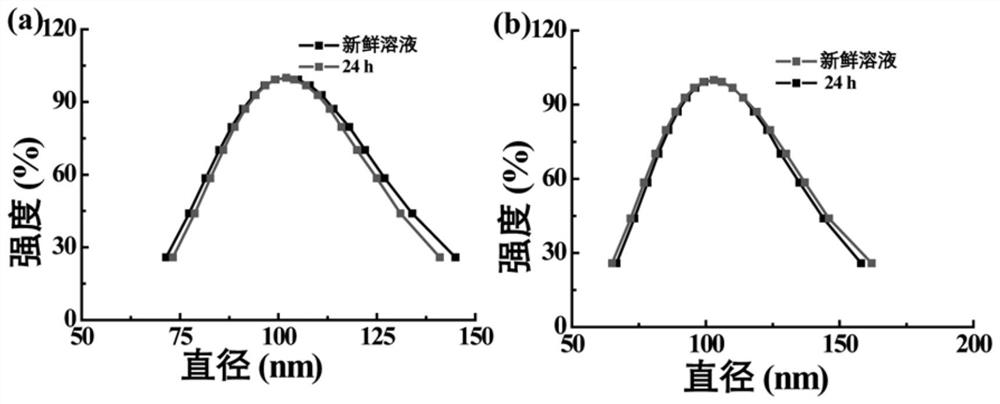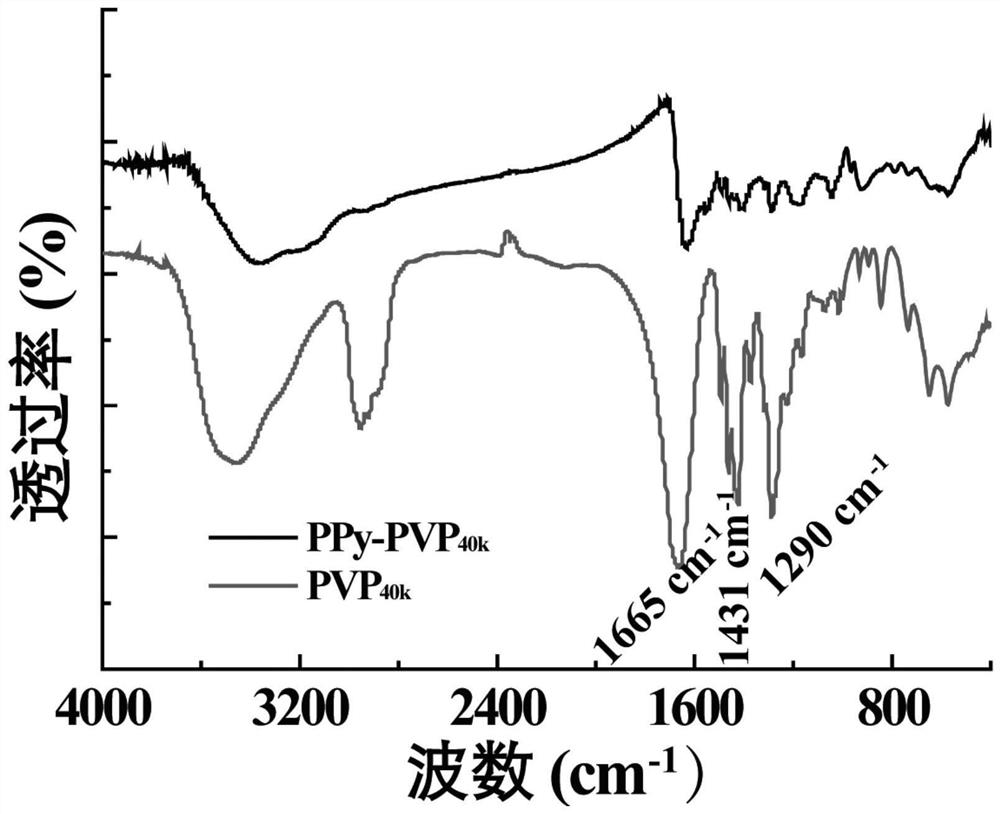Preparation method of polypyrrole nanoparticles with adjustable photo-thermal conversion capability
A polypyrrole nano- and thermal conversion technology is applied in the field of preparation of polypyrrole nanoparticles, which can solve problems such as poor colloidal stability of PPy particles, and achieve the effects of excellent photothermal conversion ability/efficiency, good biocompatibility, and energy saving.
- Summary
- Abstract
- Description
- Claims
- Application Information
AI Technical Summary
Problems solved by technology
Method used
Image
Examples
Embodiment 1
[0034] This embodiment provides a preparation method of polypyrrole composite nanoparticles, the specific steps are as follows:
[0035] Step 1: weigh 0.2g with different molecular weight (M W = 40 kDa and 360 kDa) of PVP and dissolved it in 40 mL of distilled water in a beaker.
[0036] Step 2: Add 0.62g FeCl 3 ·6H 2 O was added to the above solution and stirred at room temperature for 5 min to obtain a homogeneous yellow solution; the above solution was placed in parallel with another beaker containing 10 mL of pyrrole in a closed lid for 7 h. After the reaction, the formed PPy-PVP NPs were collected by centrifugation and washed 3 times with distilled water.
[0037] figure 1 It is the scanning electron micrograph of the PPy-PVP NPs of the embodiment of the present invention. Observation results such as figure 1 and figure 2 It was shown that under the optimal parameter conditions, the synthesized PPy-PVP NPs had good dispersion and uniform particle size.
Embodiment 2
[0039] The spectral properties of PPy-PVP were measured by a spectrophotometer in the ultraviolet-visible-near-infrared (UV-vis-NIR) range. The composition and structure of PPy-PVP NPs were analyzed using Fourier transform infrared spectroscopy (FTIR). Freeze-dried material and pure PVP were mixed with KBr and pressed into thin slices using a grinder (30MPa, 130s) to scan 4000–400cm -1 Spectral data in the range.
[0040] image 3 The results showed that in PPy-PVP 40kDa The 1290cm corresponding to PVP was detected in the spectrum of -1 、1431cm -1 and 1665cm -1 characteristic peaks at . PPy-PVP 40kDa and PPy-PVP 360kDa It has obvious absorption in the NIR region. PVP does not contribute to light absorption in the near-infrared region. Therefore, at the same concentration, PPy-PVP 40kDa The light absorption ability is higher than that of PPy-PVP 360kDa light absorption capacity, such as Figure 4 Shown in (a). Moreover, the light-absorbing capabilities of the two ...
Embodiment 3
[0042] Photothermal property test of PPy-PVP NPs. PPy-PVP NPs were dispersed into 96-well cell culture plates, and 808nm and 1064nm NIR lasers (1W / cm 2 ) for 5 minutes of continuous irradiation. The FLIR E60 thermal imaging camera is used to record temperature changes over time and the corresponding images. 808nm NIR laser (1W / cm 2 ) irradiated with different concentrations (50μg / mL, 150μg / mL and 200μg / mL) of PPy-PVP40kDa aqueous solution temperature curve and PPy-PVP 40kDa (100μg / mL) temperature curve was also recorded with 808nm laser at different power (0.3W / cm 2 , 0.5W / cm 2 and 0.8W / cm 2 ) irradiated aqueous solution. In order to calculate the photothermal conversion efficiency (η), an 808nm NIR laser (0.3W / cm 2 , 5 min) to irradiate PPy-PVP solution (100 μL, 100 μg / mL, PPy-PVP 40kDa and PPy-PVP 360kDa ). Then, the laser was turned off to cool the solution to room temperature for 5 minutes. The control group was replaced with 100 μL distilled water. Record the ...
PUM
| Property | Measurement | Unit |
|---|---|---|
| molecular weight | aaaaa | aaaaa |
| concentration | aaaaa | aaaaa |
Abstract
Description
Claims
Application Information
 Login to View More
Login to View More - R&D
- Intellectual Property
- Life Sciences
- Materials
- Tech Scout
- Unparalleled Data Quality
- Higher Quality Content
- 60% Fewer Hallucinations
Browse by: Latest US Patents, China's latest patents, Technical Efficacy Thesaurus, Application Domain, Technology Topic, Popular Technical Reports.
© 2025 PatSnap. All rights reserved.Legal|Privacy policy|Modern Slavery Act Transparency Statement|Sitemap|About US| Contact US: help@patsnap.com



